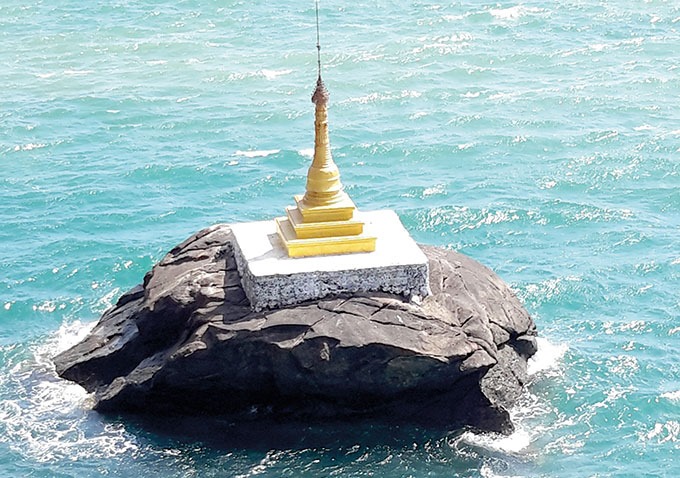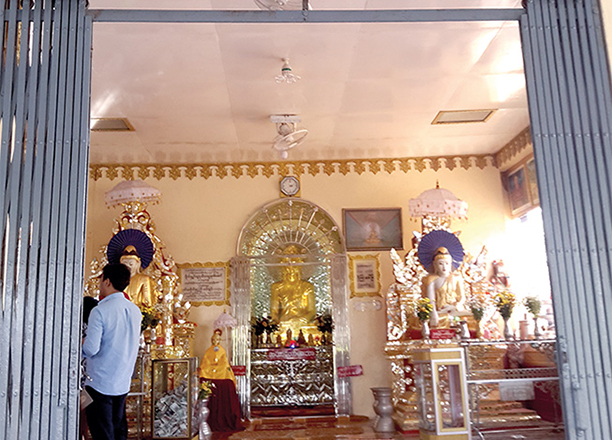By Maung Tha (Archaeology)
Despite having lesser historical and archaeological evidences, nine pagodas under titles of Shin where people from various regions of the nation make pilgrimage tours have been famous due to successive preservations.
Nine pagodas under titles of Shin, 391 miles from Yangon along the motor road, are accessible via Dawei where travellers can pay visits by car, by ship, by train and by air. Dawei, 18.6 miles from Mottama Bay, is located on the northern bank of Dawei River.
Nine pagodas under titles of Shin
The list of nine pagodas comprises Shin Tauk Htein and Shin Mokhtee as Buddha images and remaining sevens as pagodas. Shin Pin Khayu, Shin Mokhtee, Shin Okaw and Shin Datwe are situated in Dawei Township, Shin Hmyaw Taung, Shin Tauk Htein and Shin Zalun in Launglon Township, Shin Taunt Pon in Thayetchaung Township and Shin Hsandaw in Yebyu Township.
Depending on the locations, people mark nine pagodas under titles of Shin on three hills, in three jungles and three towns. The pagodas on three hills are Shin Hsandaw, Shin Hmyaw Taung and Shin Taunt Pon, in three jungles Shin Datwe, Shin Zalun and Shin Tauk Htein, and in three towns Shin Pin Khayu, Shin Okaw and Shin Mokhtee. They all can be noted as “three jungles, mountains and towns each, note down as nine Shins”.
Shin Pin Khayu Pagoda
It was assumed that Shin Pin Khayu Pagoda located on Arzani Road in South Kayinpyin Ward of Dawei was built 300 years ago. Historian Saya Maung Than Swe (Dawei) reviewed that as Shin indicates the Lord Buddha, Shin Pin Khayu should be assumed as the pagoda built on the conch between two star-flower plants.
A fire broke out almost the whole South Kayinpyin Ward of Dawei on 26 March 1996 but the pagoda remained safely. Hence, the pagoda became more famous.
Shin Mokhtee Pagoda
It was assumed that Shinmokhtee Village, six miles from Dawei, derived from Mottathunakhagara City. The pagoda in Shinmokhtee Village, located on right side of Dawei-Myeik motor road, was enshrined with Shin Mokhtee Buddha image.
Shin Mokhtee Buddha image was one of four Buddha images set adrift by Arhat Ashin Maha Araham from Ceylon Island into the sea. A saying mentioned remaining three images were Shin Mokhtaw Pagoda in Pathein, Kyaikpawlaw Hmeshin Pagoda in Thaton and Kyaikkhami mid-stream Pagoda. The place where Shin Mokhtee image was salvaged was near the bank, west of the current pagoda. Hence, a statue of nun who salvaged the image was kept at the site.
Taninthayi Division Commissioner Mr. H.M. Stevenson received 300 earthen votive tablets near Shin Mokhtee Pagoda in 1924. Back of some tablets bore inscriptions in ancient Mon language. Among them, Samim Sritri Bovanaditya means Thiri Tri Buvanaditya Dhammaraja in Myanmar-Pali language, and it was the title of King Kyansittha from Bagan city state.
Dawei was written as Htawar and Dawar in Bagan era. Governor of Dawei Dhammaraz Thamban Anandazeya (Thanbyin Anandazeya) was the loyal servant to King Kyansittha. In 955 Myanmar Era, governor of Dawei Thuriyakomma and wife donated a bronze bell weighing 100 viss to Shin Mokhtee Pagoda.
Shin Taunt Pon Pagoda
Shin Taunt Pon Pagoda built on more than 2,000 feet high hill, 18 miles from Dawei, in Thayetchaung Township. Taunt Pon means quiver or a pile of quivers. Hunter Maung Nwar abandoned his hunting livelihood and set fire to hunting equipment on the hill of Shin Taunt Pon Pagoda. Then, he himself was initiated into hermit with the title of Shin Govinda who built Shin Taunt Pon Pagoda. Although some said Shin Taunt Pon Pagoda was of work in Pyu era or early Bagan era, not firm evidence has been found yet.
Shin Hmyaw Taung Pagoda
It is a hilly pagoda in Launglon Township, located in Kyethlut Village, 52 miles from Dawei. According to the history of pagodas, Shin Hmyaw Taung Pagoda was built on the full moon day of Tabaung, 238 ME; and Bagan kings Alaungsithu and Narapatisithu performed meritorious deeds there.
At the time of rising tide, the water surface near the rock on which the small pagoda was built becomes the shape of sauce pan which does not cover the pagoda.
Some said that a small pond at North Oksin Camp, downstream of Shin Hmyaw Taung, is flown by tidal water but it remains unchanged as fresh water lake whenever tide subsides. The historical books of the pagoda mentioned six wonderful points of Shin Hmyaw Taung Pagoda.
Shin Tauk Htein Pagoda
Although some said Shin Tauk Htein Pagoda located in Kamyawkin Village of Launglon Township in Dawei District was one of nine Shin pagodas, the original Shin Tauk Htein Pagoda was the Buddha image kept in the ordination hall, east of the pagoda. People called Shin Tauk Htein Pagoda as a relic pagoda where the gala rice offering ceremony takes place on every full moon day of Thadingyut.
Shin Okaw Pagoda
Shin Okaw Pagoda, located in the precinct of Shwekyaunggyi Monastery in Peinnetaw Ward of Dawei was built with significant architectural works including 11 circular decorative bands. King of Shwetaungsar Min Shin Zaw built Shwekyaunggyi Monastery in Peinnetaw Ward in 1122 ME and then came onto the throne. He built Shin Okaw Pagoda as NanU Pagoda in the same year. King Min Shin Zaw built Shwe Taung Sar Pagoda two years after construction of Shin Okaw Pagoda.
In 1165 ME, the bell in Konbaung era donated by governor of Dawei Razathingyan and wife to Shin Okaw Pagoda mentioned 13 lines of bell inscriptions. Razathingyan was the loyal servant of King Badon who firstly established the First Amarapura City. The eighth line of the inscription mentioned Dawei was named Thayawady. That was why Dawei was called Thayawady in Konbaung era.
Shin Zalun Pagoda
Emblems of Srivaccha were expressed on concrete floral works created around the upper part of bell at Shin Zalun Pagoda, located in old Thagara city in Launglon Township. Hence, some assumed Shin Zalun Pagoda was built in contemporary of Pyu era. The Department of Archaeology and National Museum is taking responsibilities for preservation of the old Thagara city, inner and outer walls, moat and Pyu graveyard (urn mound).
Hermit Shin Govinda (hunter Maung Nwar) who built Shin Taunt Pon Pagoda adopted two children found on the road. He named Shin Zaw for the baby girl and Shin Zan for the baby boy. An Arhat who arrived there gave a sacred relic of the Lord Buddha to Shin Zan and a duplicated one to Shin Zaw.
Shin Zaw enshrined the duplicated relic into Shin Zalun Pagoda in 170 era while Shin Zan built Shin Datwe Pagoda with enshrinement of a genuine relic. Some assumed that only when women participate in hoisting the umbrella atop the pagoda built by Shin Zalun, will the process have achievement because Shin Zalun Pagoda was built by a woman.
Shin Datwe Pagoda
Shin Datwe Pagoda built by Shin Zan is located in Maungmeishaung Village, seven miles from Dawei-Yebyu motor road. As local people said as Shin Zan threw his relic into the air with a vow to build a pagoda, the relic was flying above the place of current pagoda. So, it was well-known as Shin Datwe Pagoda. A 15 feet high sitting Buddha image made of marble rock can be seen near Shin Datwe Pagoda.
Shin Hsandaw Pagoda
Shin Hsandaw Pagoda, famous as Hsandawshin Hsutaungpyae Pagoda on Kalein Hill, was built on Kaleinaung Hill in Yebyu Township. The hill is 47 miles north of Dawei.
Three pieces of relic hair of Kakusanda, Konagamana and Gotama Buddhas who had enlightened in Badda World were enshrined in the rocky reliquary which is 30 by 30 elbows each in length and width and 40 elbows in depth. A 15 elbows high Shin Hsandaw Pagoda was built on the reliquary. The Buddha Pujaniya festival of the pagoda takes place on the full moon day of Tabaung yearly.
Nine pagodas under titles of Shin, which are famous across Myanmar, do not have firmly historical evidences but they are crowded with Buddhist travellers.
Translated by Than Tun Aung
Reference:Nine pagodas under titles of Shin (Maung Than Swe, Dawei)
Selected ancient bell inscriptions (U Sein Maung Oo)
History of nine pagodas under titles of Shin (U Aung Naing)




